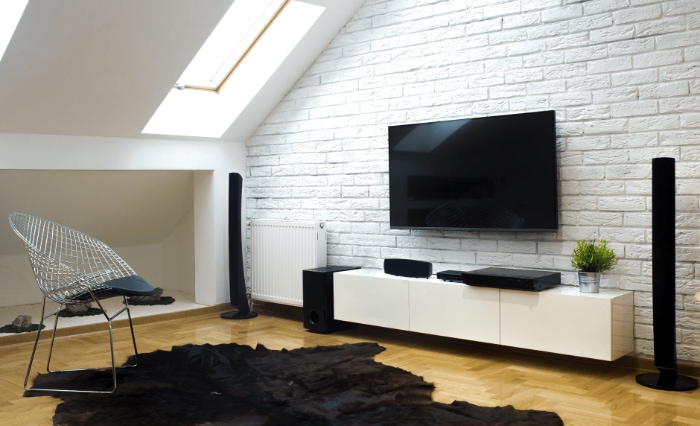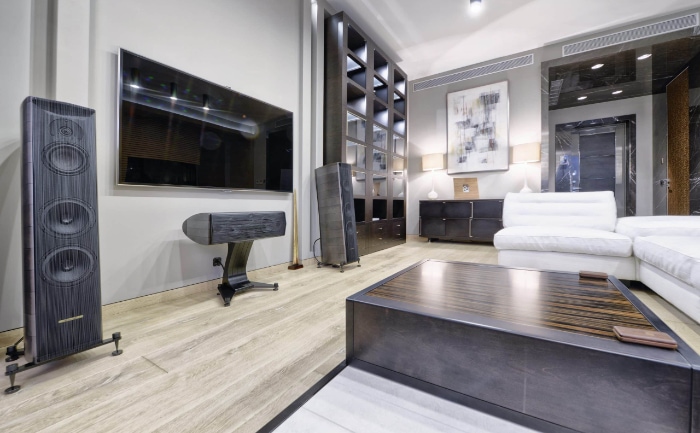Dolby Atmos vs. Dolby Digital: Reshaping Audio Realities

Sound quality transforms how we experience movies, music, and games, elevating ordinary moments into immersive journeys. Amidst the plethora of audio technologies, Dolby Atmos and Dolby Digital stand out as prominent figures, each offering unique contributions to our auditory experience.
While Dolby Digital has been enhancing our home theaters since the '90s with its crisp, dynamic surround sound, Dolby Atmos takes a leap forward, introducing us to a world where sound moves in three-dimensional space, adding depth and realism to every scene.
Dolby Digital
Dolby Digital first made waves in the audio industry in the early 1990s, revolutionizing the way sound was delivered in cinemas and eventually in homes. It was a game-changer, providing a multi-channel audio experience that significantly enhanced the realism and depth of movie soundtracks.
From its initial deployment in cinemas to its integration into DVDs, broadcasting, and streaming platforms, Dolby Digital has evolved to become a foundational element in the production and consumption of multimedia content.
Technical Insight and Functionality
At its most basic, Dolby Digital is a digital audio coding technique that compresses soundtracks to deliver multiple audio channels. This technology allows for up to 5.1 channels of surround sound, meaning it can support a setup with five speakers around the listener and one subwoofer to handle low frequencies.
The magic of Dolby Digital lies in its ability to create an immersive sound environment, placing viewers in the center of the action, whether it be the subtle footsteps of a protagonist or the roaring engines in an action-packed sequence.
Use Cases and Compatibility
Dolby Digital has become a standard across various platforms and devices, including television broadcasts, DVDs, Blu-ray discs, streaming services, and gaming consoles. Its widespread adoption is due to its compatibility with a vast array of speakers and AV receivers, making it a versatile option for enhancing audio experiences in any setting.
Consumers considering upgrading their home audio systems or setting up new ones often look to Dolby Digital as a reliable and accessible choice for achieving high-quality surround sound.
Dolby Atmos
Dolby Atmos represents the zenith of immersive audio technology, taking the concept of surround sound to new heights—literally. By adding height to the audio landscape, Dolby Atmos creates a three-dimensional sound space that more accurately mirrors real-life sound experiences.
The technology uses a combination of bed channels for ambient sounds and audio objects for discrete sounds that can move around the listener, offering an unparalleled degree of immersion. This advanced approach allows sound designers more creative freedom, leading to more nuanced and realistic soundscapes in movies, music, and games.
Enriching Experiences Across Platforms
The flexibility of Dolby Atmos technology has led to its adoption in a variety of settings, from cinemas to home theaters and even mobile devices.
Cinemas
In movie theaters, Dolby Atmos can utilize up to 64 speakers, placed around and above the audience, to create an enveloping audio environment. This setup provides a level of depth and precision in sound placement that traditional surround sound systems cannot match, making viewers feel as if they are inside the movie.
Home Theaters
For home entertainment enthusiasts, Dolby Atmos brings the cinema experience into the living room or dedicated home theater space. By adding overhead speakers or Atmos-enabled soundbars, users can enjoy a more immersive audio experience, whether they're watching movies, playing video games, or listening to music.
Personal Devices
On a smaller scale, Dolby Atmos has also been engineered to work with headphones and mobile devices, using audio processing algorithms to simulate a surround sound experience. This makes it possible to enjoy the immersive qualities of Atmos even when watching a movie or playing a game on a smartphone or tablet.
The Technical Distinctions

When comparing Dolby Atmos and Dolby Digital, the differences stretch far beyond mere names or branding. They embody significant advancements in how audio is captured, processed, and played back, affecting everything from the setup of speakers to the software used for decoding.
The Evolution of Audio Channels and Processing
Dolby Digital operates on a channel-based audio system, traditionally supporting up to 5.1 channels. This setup includes five full-range channels placed around the listener and one low-frequency effects channel designed for a subwoofer.
Dolby Digital encodes audio into these discrete channels, directing sounds to specific speakers to create a surround sound environment.
In contrast, Dolby Atmos introduces a revolutionary approach by incorporating height channels, expanding the audio landscape to include sounds coming from above. Beyond this, Atmos employs a more sophisticated signal processing technique that utilizes audio objects instead of channels.
This means sounds can be positioned and moved in three-dimensional space, offering a more dynamic and realistic audio experience. This object-based approach allows for up to 128 audio tracks and up to 64 unique speaker feeds, providing unparalleled precision in sound placement.
The Role of Audio Objects
One of the most significant innovations introduced with Dolby Atmos is the concept of audio objects. Unlike the fixed channels of Dolby Digital, where sounds are tied to specific speakers, audio objects can move freely in a three-dimensional space.
This flexibility allows filmmakers and game developers to create more lifelike and engaging soundscapes, where the movement of sound aligns more naturally with the visual elements on screen.
Dolby Digital, while effective in creating a surround sound environment, lacks this object-based audio capability, confining the audio experience to the horizontal plane and limiting the precision of sound placement.
Compatibility Requirements
The shift from channel-based to object-based audio in Dolby Atmos also necessitates changes in hardware and software to properly decode and render the sound. For cinemas, this means installing additional speakers, including overhead, and upgrading to compatible audio processors.
Home users must consider Atmos-enabled AV receivers, soundbars, or speaker systems. Additionally, the playback device and media must support Atmos; fortunately, many streaming services, Blu-ray discs, and digital downloads now offer content in Atmos format.
In comparison, Dolby Digital's requirements are less demanding, given its widespread adoption over the years. Most modern AV receivers, soundbars, and TVs support Dolby Digital decoding, making it more accessible for the average user without the need for specialized equipment.
Enhancing Entertainment with Sound
The choice between Dolby Atmos and Dolby Digital significantly influences the consumer experience across various forms of media consumption, including movies, music, and gaming. The immersive sound of Atmos, compared to the surround capabilities of Dolby Digital, presents a new frontier in auditory experience.
Transforming Media Consumption
Movies
The immersive sound of Dolby Atmos brings movies to life in a way previously unimaginable. Viewers can hear raindrops falling from above, airplanes flying overhead, and the subtle nuances of dialogue and music with clarity and depth.
This contrast with Dolby Digital's surround sound, which, while effective in distributing sound across the horizontal plane, lacks the vertical dimension that Atmos delivers.
Music
Music lovers benefit from the spatial audio capabilities of Dolby Atmos, offering a more enveloping listening experience. Instruments and vocals can be placed more precisely in the soundstage, allowing for a concert-like experience right in your living room.
Dolby Digital provides a high-quality listening experience but without the three-dimensional sound placement of Atmos.
Gaming
For gamers, Dolby Atmos can significantly enhance gameplay by providing a competitive edge. The ability to detect the direction and distance of footsteps, gunfire, and environmental sounds adds to the realism and immersion, potentially improving reaction times and overall gaming performance.
Dolby Digital offers a surround sound experience that improves upon stereo sound but doesn't provide the same level of precision and immersion as Atmos.
Real-World Impact and Considerations
The choice between Dolby Atmos and Dolby Digital can affect how consumers set up their home entertainment systems. Those seeking the most immersive audio experience possible will find Dolby Atmos appealing, despite the potentially higher cost and more complex setup due to the need for additional speakers or Atmos-enabled equipment.
On the other hand, Dolby Digital, being less demanding in terms of equipment and setup, offers a more accessible option for those looking to improve their audio experience without a significant investment.
When considering an upgrade, it's essential to weigh the types of media you consume most frequently and your budget. For avid movie watchers, gamers, and music enthusiasts seeking the utmost in immersion, the investment in Dolby Atmos could be well worth it.
However, for those who prioritize ease of setup and lower cost, Dolby Digital remains a formidable choice that significantly enhances audio quality over standard stereo sound.
The Future of Audio Technology

The landscape of audio technology is continually evolving, with Dolby Atmos and Dolby Digital leading the charge in shaping how we experience sound. The availability of content in these formats, the associated costs for consumers and producers, and the emerging trends in content production and distribution all play critical roles in this evolution.
Content Availability in Modern Formats
Dolby Digital has been a standard in audio formats for decades, ensuring its presence across a wide array of media, from DVDs and Blu-ray discs to digital streaming and broadcast television. Its established position guarantees a vast selection of content, making it accessible for the majority of consumers.
Conversely, Dolby Atmos, while growing in popularity, is still on its way to becoming as ubiquitous. Originally exclusive to premium cinemas, Atmos content has expanded to include streaming services, Blu-ray releases, and even video games, offering an enhanced audio experience to those with compatible systems.
However, the breadth of content in Dolby Atmos is not yet as extensive as Dolby Digital, primarily due to the newer technology and additional production requirements involved.
Evaluating Cost Implications
For consumers, the transition to or adoption of Dolby Atmos involves a consideration of costs, including the need for compatible speakers, receivers, and in some cases, subscription services that offer Atmos-enabled content. The investment in Atmos technology is typically higher than maintaining a Dolby Digital setup due to the advanced hardware and the potential need for more speakers to fully experience the immersive sound.
From a production standpoint, creating content in Dolby Atmos is more resource-intensive than Dolby Digital. It requires not only special equipment and software for sound mixing but also a more sophisticated approach to sound design.
These factors contribute to higher production costs, which can influence the decision-making process for content creators considering the format for their projects.
Anticipating Future Trends
The trajectory of audio technology points towards an increased emphasis on immersive experiences, with Dolby Atmos leading the way in innovation. As the cost of Atmos-compatible equipment continues to decrease and content availability expands, consumer adoption is expected to rise.
This trend is likely to encourage more content producers to invest in Atmos, further enriching the ecosystem.
Moreover, the integration of immersive audio into virtual reality (VR) and augmented reality (AR) experiences presents an exciting frontier for Dolby Atmos. The format's ability to place sounds precisely within a three-dimensional space aligns perfectly with the needs of VR and AR content, promising an even more realistic and engaging user experience.
Conclusion
Dolby Atmos and Dolby Digital stand as pillars in the world of audio technology, each offering a unique pathway to enriching our entertainment experiences. Dolby Digital has long set the standard for surround sound, offering a reliable and accessible option for enhancing audio across a broad spectrum of media.
Meanwhile, Dolby Atmos pushes the boundaries further, introducing listeners to a world where sound not only surrounds but envelops, courtesy of its innovative use of audio objects and height channels.
The balance between immersive sound quality and practical considerations such as content availability and investment in equipment forms the crux of the decision-making process for enthusiasts and casual listeners alike. As the industry leans into the future, the growing prevalence of Dolby Atmos content and the gradual reduction in costs for compatible equipment signal a shift towards more immersive audio experiences becoming the norm.
Reflecting on these advancements, it's evident that the landscape of home audio is undergoing a significant transformation. This evolution not only showcases the technological strides being made but also underscores a commitment to elevating the auditory dimension of our lives, whether we're immersed in the latest blockbuster, lost in a symphony, or engrossed in a virtual world.
The journey from Dolby Digital to Dolby Atmos marks a pivotal chapter in audio technology, promising to redefine our sonic experiences for years to come.


